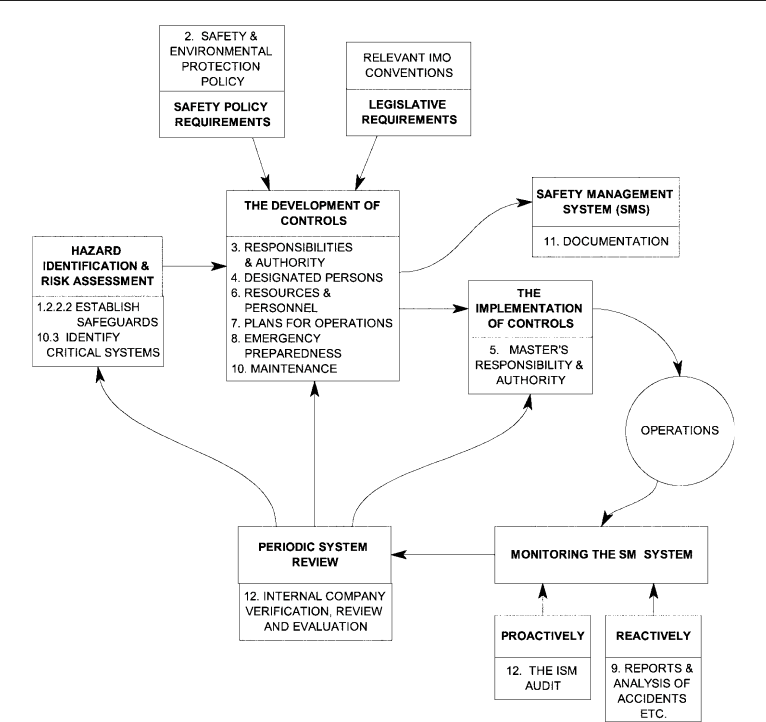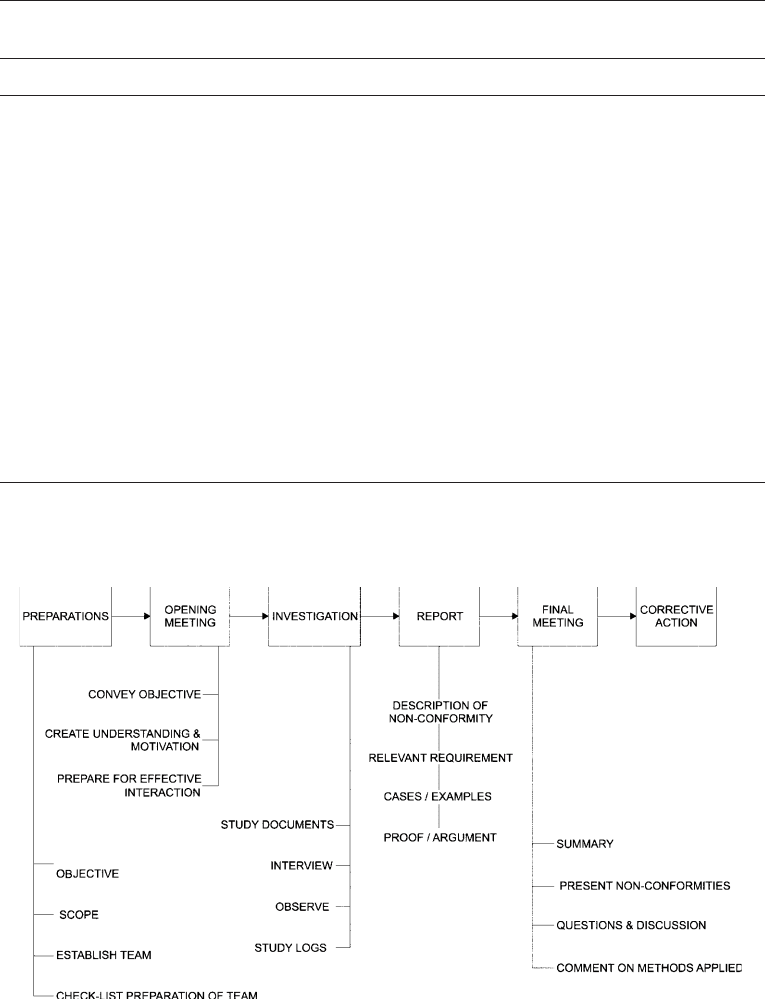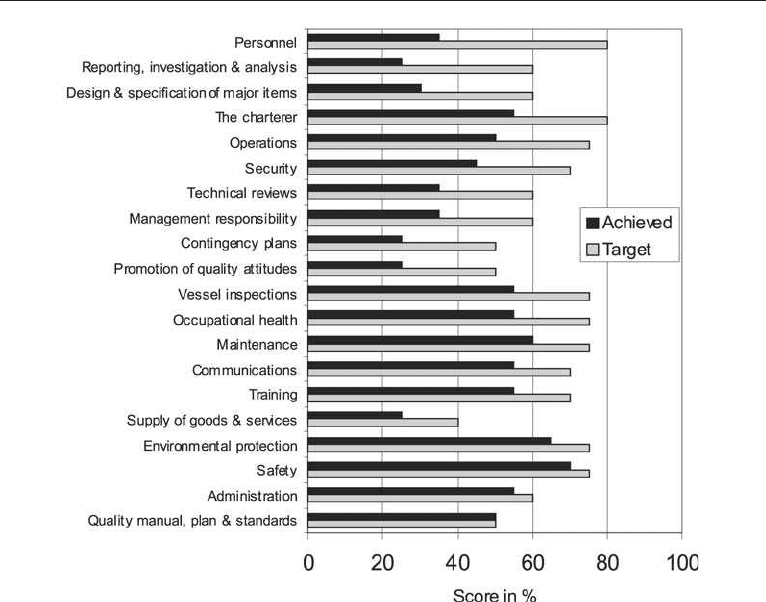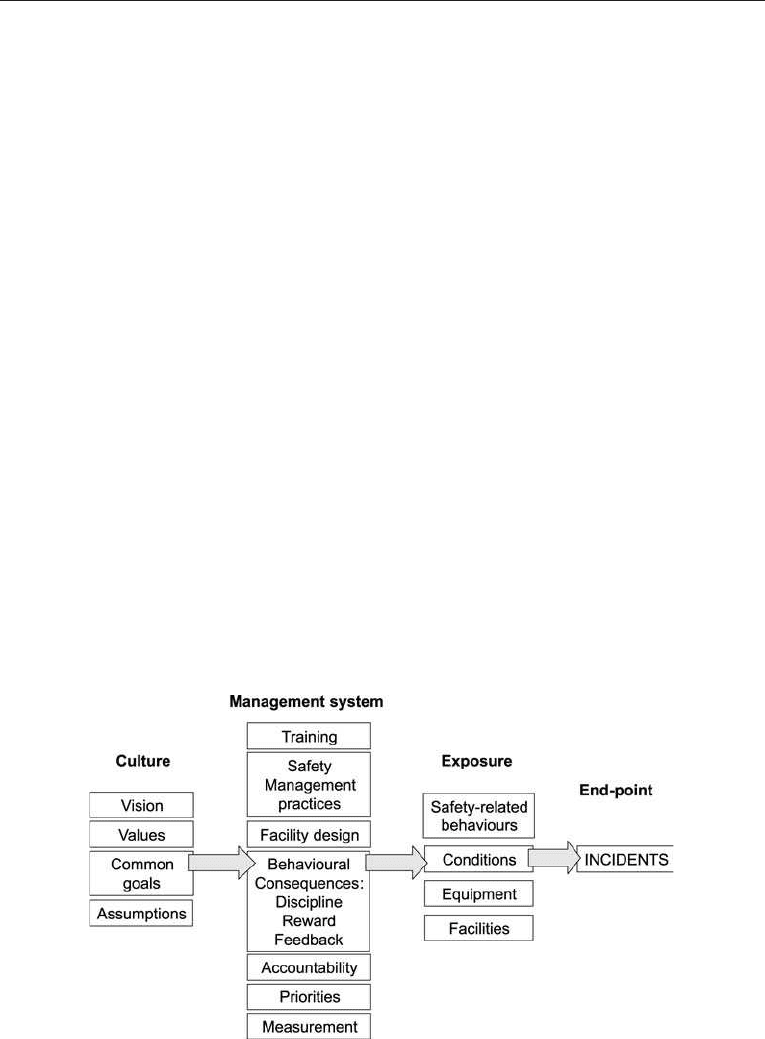Kristiansen Svein. Maritime Transportation: Safety Management and Risk Analysis
Подождите немного. Документ загружается.


ISM does not address any of the specific requirements in these conventions, but just
assumes that the managem ent system should ensure that they are adhered to.
15.3.4 The ISM Code in Practice
The ISM Code may at first glance look relatively complex, but as Bromby (1995)
has pointed out, the very idea behind the Code is a fairly straightforward learning
process which may be illustrated by Figure 15.7. Based on risk assessments, a set of
controls is developed and implemented. The safety management system will be moni-
tored and reviewed on a regular basis in order to ensure that it functions adequately
and properly.
Figure 15.6. The functional interrelationships between the different elements of the ISM Code.
486 CHAPTER 15 SAFETY MANA G EMENT

The process of risk assessment has been discussed in detail in earlier chapters and is not
commented on any further here. The concept of controls has been described earlier in this
chapter. The monitoring of the SMS in terms of the adequacy of the controls can be
undertaken using different approaches. It is common to make a distinction between
proactive and reactive methods. Proactive methods focus on how operations are
performed relative to the safety objectives, whereas reactive methods are based on what
we can learn from non-conformities and accidents. The following proactive methods can
be applied:
. Inspections
. Safety tours
. Surveys
. Audits
Inspections normally focus on the condition of equipment and systems, and have for
a long time been an established approach in safety work. Typical questions asked in
inspection include: Is the equipment /system functioning? Is the equipment damaged in
any way? Should the eq uipment be maintained?
A safety tour concentrates on how people perform their jobs/tasks relative
to established procedures. A key question is whether personnel are safety-conscious,
which can be ascertained through observation of work and conversation with
individuals.
Surveys are directed towards assessing/check ing the condition of safety-related
systems and equipment, such as evacuations systems, life-saving equipment and personal
protection equipment.
Audits are closely linked to the introduction of systematic safety management. It is not
oriented towards hardware or people but rather the management system itself. Auditing
will be discussed in greater detail in the following section.
The reactive approach is, on the other hand, based on information about:
. Acciden ts
. Incidents or near-accidents
. Non-conformities or deviations
Figure 15.7. The safety management model (adapted from Bromby,1995).
15.3 T HE I SM CODE 487

The drawback of the reactive approach is that something undesirable has to take place
before we can learn anything or implement measur es that can prevent or reduce the
consequences of such undesirable events. It is therefore a popular view that one should
concentrate on the proactive approach rather than wait for the accident with all its misery
and costs. However, one may on the contrary argue that accidents and incidents are the
only direct source of information on how and why these undesirable events/phenomena
happen. The answer seems to be that both approaches have their strengths.
15.4 A UDITING
15.4.1 What to Audit
The basis for implementing a safety management system (SMS) is the definition of
policies, an assessment of the requirements placed upon the organization, a clear view of
necessary functions and activities, the development of management procedures/routines,
as well as appropriate training. In order to assess whet her the SMS is functioning as
expected, different approaches may be used:
. Inspection of vessels
. Work observation
. Vetting of non-conformities
. Incident reporting
. Accident investigation
. Auditing
Apart from auditing, most of these approaches/methods are explained and studied in
other chapters of this book. Auditing differs from the other approaches because it is
so closely related to the introduction of formal safety managements systems (SMS). While
the other and more traditional approaches assess external parameters such as accidents,
fatalities, pollution, system conditions, and the real competence of employees, audits
focus on the elements of the SMS. In auditing, typical questions asked would include:
‘Are people well trained?’, ‘Are system reviews performed regularly?’ and ‘Are accidents
followed up with analysis and the implementation of reactive measures?’, and so on.
Saunders (1992) defines the main objects of an audit as follows:
. Policies
. Procedures
. Practices
. Programmes
. Organization
A detailed outline of these objects is given in Table 15.9.
The process of auditing consists of a number of distinct steps which are outlined
in Figure 15.8. In the initiating preparations phase the objective of the audit is defined,
488 CHAPTER 15 SAFETY MANA G EMENT

Ta b l e 1 5 . 9. The main objects of an audit
Area Description
Policies Legal requirements Budgetary provision
Statement of objectives Staffing: correct people
Mission, strategy Organizational structure
Procedures Administrative structure Recruitment
Technical procedures Safety training
Communication Supervision
Time management Discipline
Internal/public relations
Practices Costing of accidents Hazard assessment
Accident investigation Accident analysis
Data collection Equipment inspections
Medical examination HSE codes of practice
Welfare
Safety programme Enforcement Working environment
Engineering Education
Organization Organizational structure Fundamental activities
Necessary functions Emergency response teams
Figure 15.8. The auditing process.
15.4 AUDI T ING 489

and the scope (i.e. extent) of the audit is specif ied. The audit may cover the whole
company or alternatively only specific departments or functions. An important task in
the preparations phase is to establish and prepare the team to perform the audit.
The opening meeting will establish the first contact between the audit team and the
department/function that will be audited. The main purpose of this meeting is to
explain the objectives of the auditing process and how the parties will interact during
that process.
The core activity of the auditing process is the investigation phase. The starting point
of this phase will normally be to study all relevant safet y management system (SMS)
documents. Through the study of logs, interviews, and observation of key personnel
it is established whether the SMS is functioning as intended. The invest igation results
in a report where all non-conformities are documented. It is important that all deviations
are supported with relevant argumentation and documentation , and that relevant
requirements are clearly stated. The preliminary report is then circulated for comments
from all the involved departments and individuals. The final task of the audit team is
to arrange a final meeting where the findings and assessments are presented and
discussed. The audit report will then serve as a basis for taking corrective action by the
company.
15.4.2 Audit Findings
Gray and Sims (1997) have made an analysis of non-conformities found in audits on
different safety management systems, including ISO- and ISM-based systems. A statistical
summary of their findings is given in Figure 15.9. The diagram shows the number of non-
conformities found relative to given checklists for each company function. It is interesting
to note that the six dominating areas, which represent 66% of all non-conformities, are:
. Maintenance
. Documentation
. Resources and personnel
. Emergency preparedness
. Management system
. Operational procedures
An alternative format is to present the degree of attainment relative to the target values
set by the company. This may be more meaningful if one has defined a long-range plan
to improve the SMS. Figure 15.10 shows the audit results for a shipping operation
within Exxon. The functions with the greatest gap betw een target and achieved score are
listed from the top in the diagram. It is interesting to note that the largest gap was found
for ‘Personnel’ and ‘Reporting, investigation and analysis [of non-conformities]’. These
are typical ‘soft’ aspects of the SMS that are difficult to change. Illu strating this is the
finding that the quality plan itself is 100% in accordance with the target. It is a general
experience with safety management syst ems that the easiest part of quality management is
to produce plans and documentation.
490 CH APTER 15 SAFETY MANAGEM ENT

15.4.3 Auditing in the Context of the ISM Code
The guidelines for the auditing process of the ISM Code are specified by IMO (1995).
Auditing will be performed both before certification of ISM compliance and at regular
intervals after this certification. The intention of the audit is to:
. Determi ne whether the SMS co nforms with the requirement of ISM.
. Assess the effectiveness of the company’s SMS.
. Determi ne that the ships’ SMS are in compliance with rules and regula tions.
. Assess the effe ctiveness of SMS in ensuring that other rules and regulations are
adhered to.
. Assess whether the ‘safe practices’ recommended have been taken into account.
Figure 15.9. Non-conformities found in audits on different safety management systems.
15.4 AUDI T ING 491

The process of auditing involves the following steps:
. Going through the SMS documentation.
. Checking logs and other documentation that reflects the practice of the SMS.
. Interviews with key personnel in the company.
. Assessing the competence of key personnel.
. Summarizing and identifying non-conformities in the SMS.
. Assessing corrections of non-conformities.
. Granting a Document of Compliance (DOC).
One potential prob lem in terms of auditing compliance with the ISM Code is that
the Code itself and the SMS docu ments, which establish the basis for the audit, are fairly
general and open to subjective evaluation. Problems related to auditing are discussed by
Anderson (1998) and Sagen (1999), and some of these are as follows:
. General formulations in the regulations are open to interpretation.
. Difficulty in giving precise formulations of non-conformities.
Figur e 1 5.10. Target and achieved score for audited func tions.
492 CH APTER 15 SAFETY MANAGEM ENT

. How to assess the seriousness of non-conformities.
. Lack of factual evidence.
. How to pin-point lack of real competence.
. The efficiency aspect of SMS is vague.
15. 5 CORPOR ATE SAFET Y CULTURE
15. 5.1 What is S afety Culture?
So far in this chapter we have focused on how systematic management can contribute
to quality and safety. There is, however, an emerging realization that the performance
in different aspects/functions within an organization is rooted in the culture of that
organization, as illustrated in Figure 15.11 (Krause et al., 1990).
Some hold the belief that the true basis for systematic effort and genuine concern for
safety must be rooted in a safety culture of organizations. It is largely accepted that
organizational culture determines the behaviour and perfor mance of its individual
members. Organizational culture may be defined as a common set of norms and values
within an organization that override differing subunit orientations. The culture concept is
inherited from organizational theory and became a key topic in works such as In Search of
Excellence by Peters and Waterman (1982) and Corporate Cultures: The Rites and Rituals
of Corporate Life by Deal and Kennedy (1982). Culture is interdisciplinary in nature
and the understanding of the concept differs considerably between academic disciplines.
The governing view is that there are two main perspectives of organizational culture:
the socio-anthropological perspective and the organizational psychology perspective
(Wiegmann et al., 2002).
Figure 15.11. Causation of incidents. (Source: Krause et al.,1990.)
15.5 CO RPORATE SAFETY CU LTURE 493

The socio-anthropological perspective focuses on the underlying structure of symbols,
heroes and rituals, manifested in shared values tied together as practices or as visible
manifestations. This perspective can be illustrated by Figure 15.12, and the meaning of the
underlying concepts is briefly outlined in Table 15.10. The deeper structure of culture is
not immediately observable by outsi ders (i.e. those external to the organization), and may
even in some cases be difficult to articulate precisely for those within the organization
because the concepts are only subtly embedded in ‘the way we do things around here’. The
global chemical giant Du Pont is an example of a company that is seen as a pioneer in
understanding and implementing a safety culture (Koenig, 1993).
Ta b l e 1 5 .1 0 . The underlying concepts of the socio-anthropological perspective of culture
Concept Definition Examples
Symbols Words, gestures, pictures or objects
that carry a particular meaning
Warning signs, posters, slogans, safety awards,
policy documents, written rules and
procedures
Heroes Persons who are highly praised and
serve as models of behaviour
People who are rewarded by their peers and
the organization for their effort towards
safety. People who ‘walk the talk’ or practise
as they teach. People who influences other
people.
Rituals Collective activities – technically
superfluous but seen as socially
essential
Scheduled safety meetings. The secondary
effect of paying compensation to widows
and orphans after accidents.
Values Attitudes within an organization that
override differing subunit
orientations. The ‘glue’ that holds
the company together.
Behaviours that have been experienced to be
successful
Figur e 1 5.1 2. The socio-anthropological perspective of culture.
494 CHAPTER 15 SA FETY MANAGEM ENT

The organizational psychology perspective of (organizational) culture also focuses on
shared values and beliefs manifested through symbols, rituals and specialized language.
But organizational psychologists hold the view that culture has functional aspects that
can be manipulated and thereby contribute to improved productivity. In this view,
relevant aspects of the culture concept are organizational commitment, social stability and
motivation. The perspective is also more rational in the sense that the culture concept can
be broken down analytically and manipulated.
Wiegmann et al. (2002) made a comprehensive literature review on studies of the safety
culture concept, and this review clearly showed that people understand the term safety
culture differently. Despite this the authors were able to pin-point some common or
related definitions:
. Shared values by a group or orga nization
. Emphasizes the contribution by everyone at every level
. Impact of the behaviour of each member at work
. Reflect s the contingency between reward systems and safety performance
. Willingness to learn from errors, incidents and accidents
. Is relatively enduring, stable and resistant to change
. High value put on worker and public safety
. Shared values, beliefs and norms
. Sub-facet of organizational culture
. A joint belief in the importance of safety
The understanding of the term ‘safety culture’ is not made easier by the fact that the
term ‘safety climate’ also is commonly used. According to Wiegmann et al. (2002), a
possible interpretation of the latter term may be that the safety climate is a temporal
measure of the safety culture, or perceived state of the culture, at a particular place and
time. The following definitions of safety climate are offered in the literature:
. A psychological phenomenon: perception of a safety state
. Intangible issues such as situational and environmental factors
. A ‘snapshot’ of the safety culture – unstable and subject to change
. Procedures and rules
. The surface features of the safety culture
. Percepti ons of safety systems, as well as job and individual factors
. Percepti ons about the relative importance of safe conduct
15.5.2 Measu ri ng Safety Cu ltur e
Wiegmann et al. (2002) propose a set of organizational indicators that may give a more
operationally oriented view on safety culture. These indicators are presented and explained
in Table 15.11, and may be used in terms of measuring safety culture.
Similarly, one may assess safety cultures using the following benchmarking
criteria, which are more concrete than the organizational indicators for safety culture
15.5 CO RPORATE SAFETY CU LTURE 495
